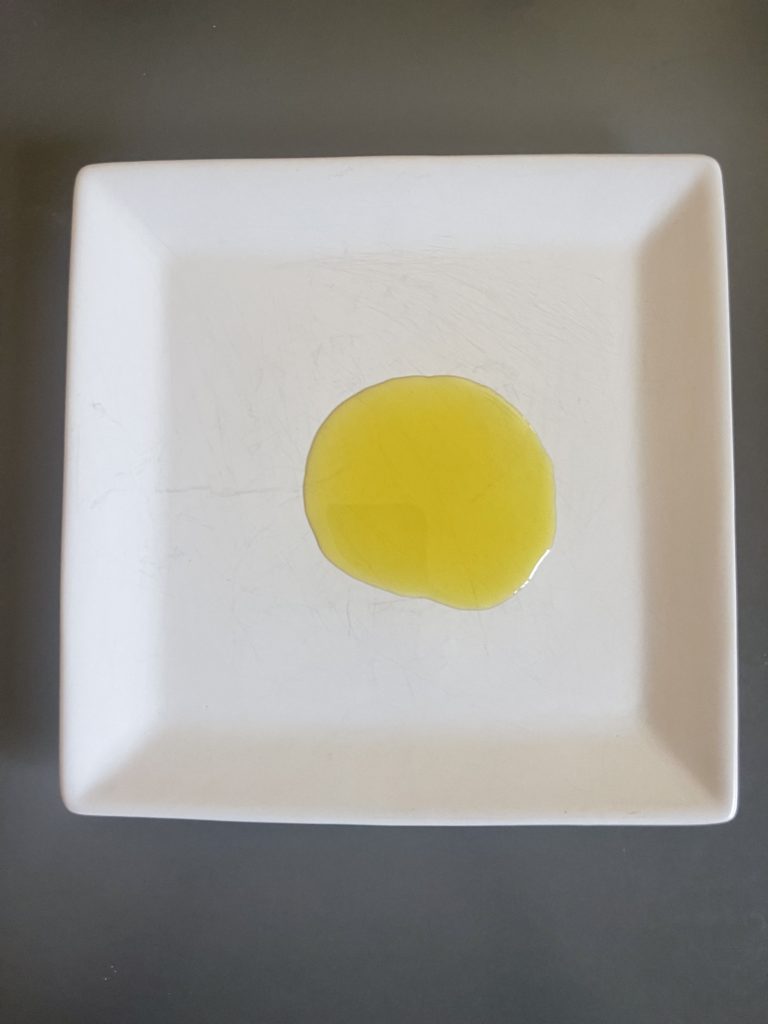In the market for high quality olive oil that hasn’t gone rancid? Here is a quick buying guide.

A bottle of ‘olive oil’ contains oil that was refined, treated, and likely homogenized. This means that the subtleties of flavor have been stripped away. This oil is typically lighter in color and has a much milder flavor.
Genuine extra virgin olive oil, in contrast, skips this processing and is intensely tested to ensure quality from picking through bottling.
Extra virgin olive oil (EVOO) can also be homogenized. Bigger producers often blend different varieties of olives (all extra-virgin) from different countries. But as with coffee, EVOO offers an opportunity for single-origin products. Producers create labels that highlight the olive varietal or the estate where the olives grew. Ideally, the pressing and bottling happens on-site to preserve freshness and minimize associated transport emissions.
Most olive oil comes from Italy, Greece, and Spain, though California also boasts some beautiful olive farms, as do Chile and Australia. As with most things, you’ll get a better product from olive oil made from olives grown closer to home.
When shopping for olive oil, check for freshness. Most oil starts to spoil around 12 months after the olives are harvested. By 18 months, it’s typically rancid and only usable for non-culinary purposes. But olive oil expiration dates can be confusing. The listed date is typically based on when the oil was bottled, not when it was harvested. This means the oil may have been sitting around for months before bottling, giving you less time to use it after purchase. If possible, look for a harvest date instead of an expiration date.
Most oil starts to spoil around 12 months after the olives are harvested. Always look for a harvest date instead of an expiration date.
The environmental impact of olive oil production
The nutritional makeup of olive oil doesn’t vary hugely between organic and non-organic, but nutrition isn’t my only consideration when choosing healthier olive oil. Why? Because there’s a huge environmental impact associated with the dramatic expansion in olive oil production worldwide.
In Mediterranean countries, for instance, reports suggest that non-organic olive oil production has led to large-scale soil erosion. Olive oil farming is also threatening local ecology in Italy, Spain, and other countries in the region.
Most of the world’s olive oil comes from Andalusia. Olives gobble up a whopping 30% of the agricultural land of Andalusia and 59% of the total olive grove land in Spain. This also accounts for 30% of the total olive grove land in the European Union or 1.5 million hectares.
Traditional methods of olive oil production actually promoted biodiversity. Farmers used low-intensity practices, few (or no) agrochemicals, and had beautiful olive groves boasting old olive trees surrounded by herbaceous plants in areas with a variety of other land uses.
This ‘ecological richness’ has been lost in recent years due to modern, intensive olive farming practices. Most olive oil now comes from farms that are larger, single-crop, and reliant on machinery and pesticides. The soil is largely uncovered, resulting in massive soil erosion and a loss of nutrients, biodiversity, and sustainability.
The ‘ecological richness’ of olive groves has been lost in recent years due to modern, intensive olive farming practices.
Mono-cropping also tends to require larger inputs of synthetic fertilizers and pesticides to overcome issues that simply don’t arise on permaculture farms.
Sustainable olive oil packaging
It’s best to store olive oil in an opaque container made of glass or tin. These containers won’t leach chemicals into the fats during storage, unlike plastic. You can also easily recycle glass and tin. The downside is that glass is heavy to ship and can break if not properly transported and stored.
If you use a lot of olive oil, the best approach is usually to buy a big tin that you can eventually recycle. Store this tin in a cool, dark place and decant small amounts of oil into an opaque dispenser that you keep in your kitchen for immediate use. If you don’t have room to store a big can of olive oil, try to find a local zero-waste store and take your own small opaque bottle to refill instead. This will ensure fresher oil and help reduce waste and energy involved in shipping and recycling bottles.
Another option is to collectively buy a big can of olive oil and then decant some for friends and family. This way, you’re more likely to use the oil before it goes rancid. Bulk orders also help reduce overall packaging and shipping, as well as money. If you bought a tin and aren’t sure you’ll get through it all as cooking oil, consider turning some into soap or other body care products.
At all costs, avoid buying olive oil in plastic bottles. These almost always end up in landfills. If you do have a plastic bottle, check for a PET #1 symbol and recycle this along with similar plastic containers. Avoid bottles with a #3 symbol as these are much harder to recycle. Don’t refill #1 or #3 bottles or reuse other plastic containers as these plastics degrade quickly and can leach nasty chemicals such as BPA and phthalates into your cooking oil.
Whichever package of olive oil you buy, don’t commit the culinary sin of storing the oil right by your stovetop. This is the ideal place to ruin the olive with heat and light exposure, meaning your oil will start tasting nasty, and you’re more likely to waste it!